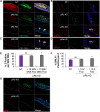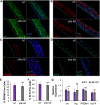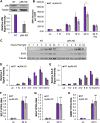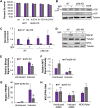Retinoblastoma Protein Is Required for Epstein-Barr Virus Replication in Differentiated Epithelia
- PMID: 36719239
- PMCID: PMC9972952
- DOI: 10.1128/jvi.01032-22
Retinoblastoma Protein Is Required for Epstein-Barr Virus Replication in Differentiated Epithelia
Abstract
Coinfection of human papillomavirus (HPV) and Epstein-Barr virus (EBV) has been detected in oropharyngeal squamous cell carcinoma. Although HPV and EBV replicate in differentiated epithelial cells, we previously reported that HPV epithelial immortalization reduces EBV replication within organotypic raft culture and that the HPV16 oncoprotein E7 was sufficient to inhibit EBV replication. A well-established function of HPV E7 is the degradation of the retinoblastoma (Rb) family of pocket proteins (pRb, p107, and p130). Here, we show that pRb knockdown in differentiated epithelia and EBV-positive Burkitt lymphoma (BL) reduces EBV lytic replication following de novo infection and reactivation, respectively. In differentiated epithelia, EBV immediate early (IE) transactivators were expressed, but loss of pRb blocked expression of the early gene product, EA-D. Although no alterations were observed in markers of epithelial differentiation, DNA damage, and p16, increased markers of S-phase progression and altered p107 and p130 levels were observed in suprabasal keratinocytes after pRb knockdown. In contrast, pRb interference in Akata BX1 Burkitt lymphoma cells showed a distinct phenotype from differentiated epithelia with no significant effect on EBV IE or EA-D expression. Instead, pRb knockdown reduced the levels of the plasmablast differentiation marker PRDM1/Blimp1 and increased the abundance of c-Myc protein in reactivated Akata BL with pRb knockdown. c-Myc RNA levels also increased following the loss of pRb in epithelial rafts. These results suggest that pRb is required to suppress c-Myc for efficient EBV replication in BL cells and identifies a mechanism for how HPV immortalization, through degradation of the retinoblastoma pocket proteins, interferes with EBV replication in coinfected epithelia. IMPORTANCE Terminally differentiated epithelium is known to support EBV genome amplification and virion morphogenesis following infection. The contribution of the cell cycle in differentiated tissues to efficient EBV replication is not understood. Using organotypic epithelial raft cultures and genetic interference, we can identify factors required for EBV replication in quiescent cells. Here, we phenocopied HPV16 E7 inhibition of EBV replication through knockdown of pRb. Loss of pRb was found to reduce EBV early gene expression and viral replication. Interruption of the viral life cycle was accompanied by increased S-phase gene expression in postmitotic keratinocytes, a process also observed in E7-positive epithelia, and deregulation of other pocket proteins. Together, these findings provide evidence of a global requirement for pRb in EBV lytic replication and provide a mechanistic framework for how HPV E7 may facilitate a latent EBV infection through its mediated degradation of pRb in copositive epithelia.
Keywords: EBV; Epstein-Barr virus; HPV; cell cycle; epithelium; human papillomavirus; organotypic raft; replication.
Conflict of interest statement
The authors declare no conflict of interest.
Figures










Similar articles
-
Epstein-Barr virus replication within differentiated epithelia requires pRb sequestration of activator E2F transcription factors.J Virol. 2024 Oct 22;98(10):e0099524. doi: 10.1128/jvi.00995-24. Epub 2024 Sep 18. J Virol. 2024. PMID: 39291960 Free PMC article.
-
Inhibition of Epstein-Barr Virus Replication in Human Papillomavirus-Immortalized Keratinocytes.J Virol. 2019 Jan 4;93(2):e01216-18. doi: 10.1128/JVI.01216-18. Print 2019 Jan 15. J Virol. 2019. PMID: 30381489 Free PMC article.
-
Epstein-Barr Virus Infection Promotes Epithelial Cell Growth by Attenuating Differentiation-Dependent Exit from the Cell Cycle.mBio. 2019 Aug 20;10(4):e01332-19. doi: 10.1128/mBio.01332-19. mBio. 2019. PMID: 31431547 Free PMC article.
-
Role of Epstein-Barr Virus and Human Papillomavirus Coinfection in Oral and Anogenital Carcinogenesis: Potential Tumorigenic Pathways.Crit Rev Oncog. 2019;24(4):403-413. doi: 10.1615/CritRevOncog.2020033071. Crit Rev Oncog. 2019. PMID: 32421994 Review.
-
Spectrum of Epstein-Barr virus-associated diseases.Annu Rev Pathol. 2006;1:375-404. doi: 10.1146/annurev.pathol.1.110304.100209. Annu Rev Pathol. 2006. PMID: 18039120 Review.
Cited by
-
Identifying the key regulators orchestrating Epstein-Barr virus reactivation.Front Microbiol. 2024 Dec 5;15:1505191. doi: 10.3389/fmicb.2024.1505191. eCollection 2024. Front Microbiol. 2024. PMID: 39703703 Free PMC article. Review.
-
Epstein-Barr virus replication within differentiated epithelia requires pRb sequestration of activator E2F transcription factors.J Virol. 2024 Oct 22;98(10):e0099524. doi: 10.1128/jvi.00995-24. Epub 2024 Sep 18. J Virol. 2024. PMID: 39291960 Free PMC article.
-
PRDM1 promotes the stemness of gastric cancer cells by enhancing the transactivation of Myc.Transl Oncol. 2025 Sep;59:102443. doi: 10.1016/j.tranon.2025.102443. Epub 2025 Jun 18. Transl Oncol. 2025. PMID: 40532656 Free PMC article.
-
Modulation of Epstein-Barr-Virus (EBV)-Associated Cancers by Co-Infections.Cancers (Basel). 2023 Dec 7;15(24):5739. doi: 10.3390/cancers15245739. Cancers (Basel). 2023. PMID: 38136285 Free PMC article. Review.
-
IRF6 controls Epstein-Barr virus (EBV) lytic reactivation and differentiation in EBV-infected epithelial cells.PLoS Pathog. 2025 Jun 26;21(6):e1013236. doi: 10.1371/journal.ppat.1013236. eCollection 2025 Jun. PLoS Pathog. 2025. PMID: 40569988 Free PMC article.
References
Publication types
MeSH terms
Substances
Grants and funding
LinkOut - more resources
Full Text Sources

